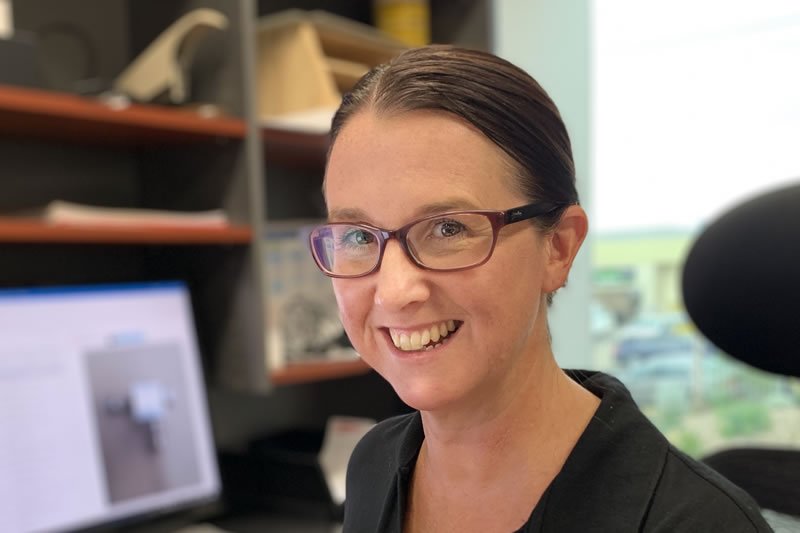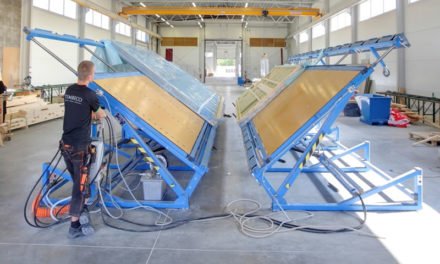Behind every great piece of timber machinery is a service department. We speak to Hundegger’s Australasian service manager Karen Steyn about taking on this vital role.
Machinery lies at the heart of much of the timber industry, and often represents the most significant outlay to any business. So it’s vital that downtime is kept to a minimum and the useful working life of any equipment is long enough to pay back its – often substantial – initial financial investment.
For Hundegger customers, this is where Karen Steyn and her team step in. “It’s a bit unusual having a woman in the role,” says Sam Rowe, general manager at Hundegger Australia. “It’s a blokey industry and in all my years I’ve not seen another woman heading up a service department, but it was just a no-brainer for us to put Karen in that role.”
As the Australasian service manager, Steyn oversees the company’s Australian and New Zealand customers, organising schedules for regular servicing to keep machines running as well as possible and managing any emergencies that arise. “It’s very much like a car,” Steyn says. “Things start to wear and if you don’t get them serviced regularly and on time, that creates bigger issues and bigger faults down the line.”
Her team of six national techs looks after the Australian operation, working on site much of the time, or remotely (often in tandem with local electricians and/or the international Hundegger technical team, based in Germany) for emergencies.
“We arrange a yearly schedule for our customers,” Steyn explains. “Sometimes that’s one service a year, sometimes that’s six to eight, it depends on the machines and the use. Looking at the appointments for any month, I’ll go through and allocate technicians to those jobs and send out the details of the service to our admin team. They then book flights and accommodation, make sure the appropriate parts will be on site… all that sort of thing.”
Dealing with an enormous territory is less daunting than it looks, Steyn explains: “We deal with the majority of unexpected problems remotely. We’ve got a system where we can log into the customers’ machines online and view their incident logs and from that we can try and assess what’s going on. We can either get an electrician who’s local to them in to have a look while we talk to the electrician online or, if that doesn’t work, we can refer the matter to Germany, who can sometimes sort it for us. If doesn’t work, we send out an emergency tech to swap or replace parts.”
Surprise career
For someone who enjoys juggling schedules and talking machinery parts as much as Steyn does, it’s a surprise to learn she doesn’t come from a service, or even a timber, background. Instead, she began her career in finance.
“Ten years ago, after giving birth to my first child, I was looking for a job close to home. Charlie [Hutchings, managing director and owner of Hundegger Australasia] offered me a job in admin and I gradually took over the running of the accounts: bookkeeping, office management, logistics for all the services guys and the parts. It just grew from there.”
Last year, Steyn took extended leave to travel around Australia with her family. When she returned, it was to learn that the company had reorganised a little and wanted to take advantage of her comprehensive systems and product knowledge by installing her as service manager.
“She progressed through so many parts of the company and got to know the customers really well,” says Rowe. “While she’s not the stereotypical service manager, she has amazing hands-on knowledge. It’s like when I take my car in for a check-up. I don’t expect the person who books me in and calculates time and cost to be the best mechanic. They’ve got mechanics out the back. That person is all about customer experience and making sure that they’re allocating the resources to get the job done and keep me happy. That’s where Karen’s so great.”
“I thought it would be a really good challenge,” Steyn says. “I know how the business works inside and out and, while I can’t service a machine, I know all the parts and the components so I thought, why not give it a go?”
Despite a successful opening run, she is modest about her achievements so far: “At this stage I’m still learning the ropes. It’s been a massive learning curve in terms of taking on all the actual servicing side of things and learning how the machines work. Actually seeing the machines in action is a different thing to just the components.”
And there have been a few unexpected incidents along the way. “One of the guys found a wasps’ nest in a machine when he took the cover off to clean it,” Steyn says. “Happily, the wasps had already moved out before he got there!”
Showing commitment
Many companies have stepped away from a service ethos that prolongs the life of products. Computers and even cars aren’t expected to last more than a few years, appliances often less. While a Dualit toaster designed in 1952 can still be repaired and work perfectly today, a flash new toaster will likely be tossed for scrap before 2024.
“We’re…” Steyn searches for the right way to put it without being rude about other companies. “We do things a bit differently. The oldest machines Hundegger sold in Australia are 10-15 years old. When I joined Hundegger in 2009, we were selling SC-1’s and we had a few of those installed before I got here. We also have a couple of second-hand machines in the market and I’m not quite sure how old they are, I just know when we took over servicing for them.”
Hundegger continues to offer service support and parts for older models. “One of our customers has just had a refurbishment done on their SC-1,” says Steyn. “They’ve gone through a process where they’ve replaced quite a lot of components and we’ve spent a lot of time working on the machine to get it back up to scratch and working as well as one of the new machines. Sure it can’t do some of the fancy stuff, but in terms of cutting timber and cutting timber well, it’s right up there. They’re saying that the machine is working better than it ever has before.”
While Steyn jokes that her team may have done the company out of the sale of a new machine, she is serious about the commitment to service Hundegger provides, pointing out that many businesses build their systems around their plant and that there are good reasons aside from budget why people might want to stick with an older unit.
“The machine is there, it’s up and running. By spending less than they would on a new machine, they’ve got one that’s doing exactly what they need it to do, and it fits precisely into how their business runs, with no need for extra training,” she says.
Keeping customers working
While Hundegger is famous for its range of sophisticated new machines, Steyn insists it makes good business sense to operate for all their customers, both the keen early adapters and the more conservative type who like to stick with old favourites.
“They see that we’re not just trying to sell them a new machine, that we’re happy to keep the machines they’ve got up and running. If we’ve got a machine running well, that helps the customer and then when others talk to them, we get good press, good word of mouth, so that works for both of us.”
For such sophisticated machines, issues are often simple: a software glitch than can be fixed remotely in minutes, or a damaged part that can be easily replaced, often by the user. Many problems arise from minor lapses in work practices, such as regular cleaning falling off during an unusually busy month, so Steyn gently reminds customers not to let routine care slip by undone.
She brings a similarly calm approach to innovation in the service department. One of the key technicians from Germany has recently been out training Australian staff on new methods, but Steyn is looking to improve, not overhaul, the processes.
“One change is that we’re getting a new service system up and going at the moment. All our service reporting has been manually based, and we’re moving that online, so the customer will get a report immediately rather than having to wait three to four days for us to process it internally.”
With her team garnering positive feedback, Steyn says her approach is similar to many of Hundegger’s machine owners. “I’m quite happy doing what we’re doing, but as we see places to improve, that’s where we’ll start making a few changes.”
For more, visit www.hundegger.com.au












